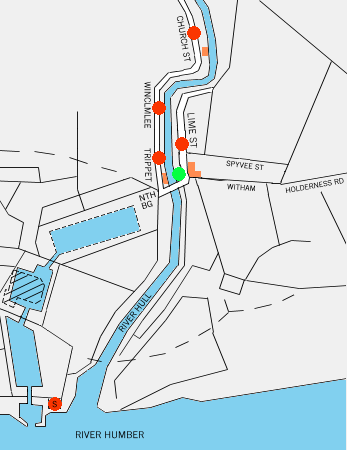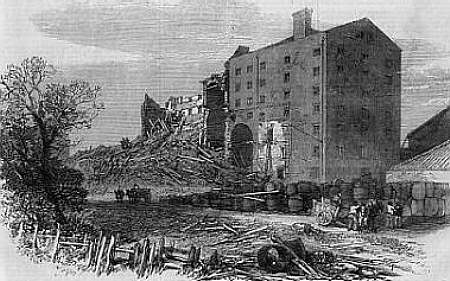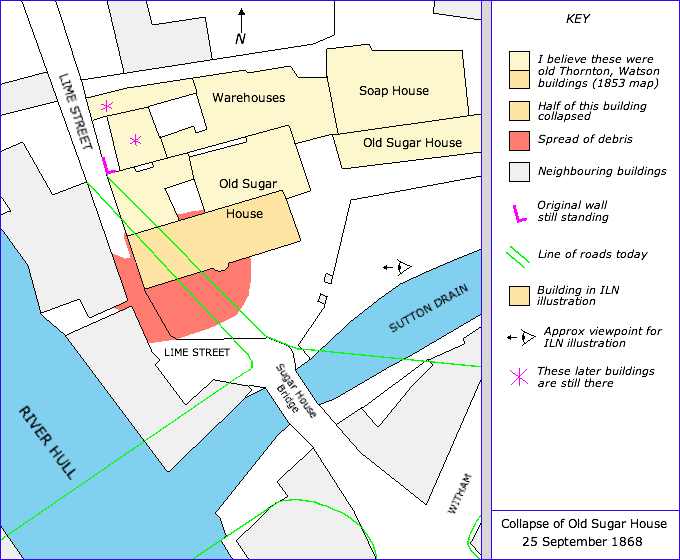1732-1841 THORNTON, WATSON & Co
Click for Picture of Old
Sugarhouse.

1732-1841 THORNTON, WATSON & Co
Click for Picture of Old
Sugarhouse.

1658-<1673 SMITH William & CATLIN William

1740s-70s DELAMOTTE, BEEL & Co
1770s-90 BINE Francis
1790-8 BASSANO, CARLILL & Co (inc BOYES & LEVETT)
1818 BASSANO & LEVETT

1798?-1817 BOYES, G F & Co

17th century - at similar time to Trippet sugarhouse

HULLCLICK the (For local directory of sugar houses, click here.) (For national directory of sugar houses, click here.)
The width of this map represents 1ml / 1.6km. |
 |
**************************************
THORNTON, WATSON & Co., Lime Street ... 1730s - Present.
(left) The newly built Sugar House; (right) The old sugar house as a Warehouse, after the collapse of the main building and the changed line of Lime St. - "Evidences relating to the Eastern part of the City of Kingston-upon-Hull" by Thomas Blashill, 1903.
The original partners, and some of the changes that followed ... 1733 ... 1771 ... (1778 Will of Samuel Watson mentions his shares in sugarhouses in Hull.) 1782 ... (1790 Will of John Thornton - his interests to Samuel, Thomas & Henry Thornton.) 1802 ... 1821 ... 1823 ... (1838 Will of Samuel Thornton mentions shares in three sugarhouses in Hull.) [Refer to Lambeth Archives - The Thornton Papers Ref IV/104 for more detail of the above. Wills available online from TNA.] 1841 ... To be sold by private contract or let on lease ... 1844 ... To be sold by private contract ... The site was sold, and the huge main building was used for the storage of linseed ... each floor filled to within a foot of the ceiling, and then ... 1868 ... |
 |
The Old Sugar House, Lime Street, Hull - from The Illustrated London News, 1868.
|
THE FATAL DISASTER AT HULL - 1868 The newspaper reports at the time gave considerable detail regarding the hours before the collapse, the falling of the building and the rescue attempts made throughout the afternoon. The inquest on the eight who died, one of whom was a 6 year old boy just passing the building, concluded that the collapse was caused by the overloading of a building already weakened by decades of subsidence of the pillars and foundations that held the lower floor. The jury gave a verdict of 'Accidental death from the fall of a warehouse', and suggested that all such old buildings that were to be converted to store seed should be inspected by the Board of Health for their suitability. |
 |
|
2007, April ... This may well be all there is to show for a sugarhouse that refined for more than 100yrs, but when the site becomes vacant again it would be good to think that a more detailed and professional study could be undertaken, and when the site is eventually redeveloped perhaps the names of buildings, streets, etc might reflect its previous use.
So, if you walk across North Bridge, turn left and walk along Lime Street for about 35-45 paces, STOP and you are in the old sugarhouse. Close your eyes and imagine the working conditions !!
2008, June ...
I've attempted to show how the old sugar house might have looked back in the early-mid 1800s ... a huge building, with the Sutton Drain running in front.(upper left) The line of the drain can be seen today running across the southeast corner of the site and fixed by the Victorian(?) bridge parapets that still exist on either side of New Cleveland Street, pointing the Drain directly at the new North Bridge.(lower left) I hope a professional study of the site will take place, at least to make an assessment of its archaeological worth, before the diggers move in !!
2011, Jan ...
2011, Apr ...
2011, Jul ...
So there it is, the car park on the sugarhouse ... a pristine tarmac roof covering all that is beneath.
2012, Jun ...
2013, Oct ... The Sugarhouse Car Park is not yet in use. It seems there'd have been ample time for the archaeologists !! 2014, Jan ... North Bridge Car Park is now open ...
... with almost 200 spaces to choose from, but when you park please remember that ...
marks the spot where hundreds of men refined sugar for more than a century, where scores of men stored linseed for a couple of decades ... and where seven men, and a boy passing by, were killed when half the building collapsed.
This is not just a car park, it's an important part of Hull's industrial history.
************************************** ANOTHER SUGARHOUSE ...
I have often wondered why it has been reported that the Lime St sugarhouse "failed almost immediately"(1), when its progress is well documented for some 110 years ... I'm sure the Thornton family would not have continued to pour money into a failed business for all those years. Another sugarhouse - no exact location, no exact owners' names - was actually built in 1740 on "the growths" in Sculcoates on the west bank of the River Hull.(2) Within just 6 months, this sugarhouse had caused much concern, not because of its effect upon other businesses but because of its effect upon the river itself. This sugarhouse seemed doomed, and I now wonder if there has been confusion between this and the Lime St sugarhouse ... especially if the T_____n was Thornton, however there's a suggestion it might be Thompson & Pease(4). In 1774, Elizabeth Thompson married. Settlement was made on 20 Aug and part of it reads, "... All that moiety or second part of messuage tenement dwelling house garden sugarhouse warehouse outhouses staithes jetties grounds lands and hereditements belonging in Sculcoates appertaining in tenure or occupation of Charles Delamotte & Joseph Thompson now in occupation of John Coleman & Co ..."(5). 1. 'A History of Kingston upon Hull' by Hugh Calvert, Phillimore, p.205. ************************************** WINCOLMLEE ...
It was the sugarhouse on Wincolmlee (which I feel sure cannot have been the one above) that was the competition to Thornton & Watson. Gordon Jackson wrote in 1972 in his "Hull in the 18th Century" ... Source : "Hull in the Eighteenth Century" by Gordon Jackson, OUP, 1972. [Parish Registers show that Francis Bine was buried at Kirk Ella on 15 Oct 1787.] |
|
|
|